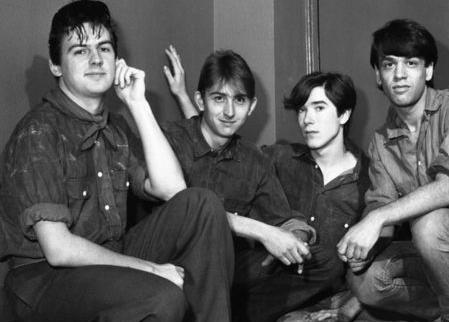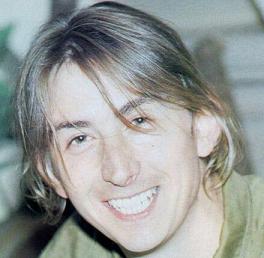|
(Translated from my original Italian text by DommeDamian)
Talk Talk
lived one of the most schizophrenic careers in rock history. They
established themselves in the days of synth-pop with
harmless dance songs, but later developed one of the most original trance music
of their time, which preceded the revival of ambient music.
Mark Hollis brushed their 1982
hits Today (which would remain their greatest success)
and Talk Talk , collected on The Party's Over (EMI,
1982), not very different from those of Duran Duran and Depeche Mode,
under the banner of dance-music as hopelessly romantic as it is
frivolous.
Hollis did not, however, have the
charisma of the most popular British stars and, compared to the
super-productions of their contemporaries, his songs had an amateurish
quality. Such A Shame , It's
My Life and Dum Dum Girl , the milestones of It's
My Life (1984), the first collaboration between Hollis and new
keyboardist Tim Friese-Greene, went almost
unnoticed. The only country where sales increased was Italy.
Although the group continued to churn
out backbone singles like Life's What You Make It (1985) and Living
In Another World (1986), the third
album The Color of Spring (EMI, 1986) actually marked a
drastic evolution. In fact, there were songs played in the name of an
extraordinary acute sleepwalking trance and a gem like Happiness Is
Easy. The "group" was in reality simply the Hollis and Friese-Greene duo accompanied by veterans such as Stevie Winwood. The
album restored their commercial fortunes. It's “muzak",
but atmospheric very classy.
That was the vein of the last
season. Spirit of Eden (EMI, 1988) contains only six long
free-form pieces that vegetate at low volume with a barely sketched
development.
Rainbow opens with faint whistles of trumpets and electronics,
which give rise to drones from the end of the world, to dull background noises,
as some sort of decomposition. It takes three minutes before the icy
silence is perturbed by melancholy bluesy phrasing of guitar and harmonica and
the song intones its grim elegy. After another three minutes the singing
is lost, and only fleeting chords of piano, organ and trumpet remain to float
nostalgically on the surface, while the guitar resumes its sad theme,
accompanied by an increasingly desperate harmonica. The rhythm rises for a
few seconds and the song's hymn acquires a psychedelic depth. Everything
is subtly calculated for maximum effect. A dozen instruments contribute to
the arrangement, even if its effect is that the arrangement is spartan.
The rest also basks in the contemplation of abstract visions, in sound
sculptures that are more and more timbral than
narrative.
Even when the song does not deviate too much from the canons, in comparison
to Eden, the development is as if held back, slowed down,
disoriented, fades and rears without haste, lingering in every whim of the
arrangement, extending to the maximum the trance that joins one state of
lucidity to the next. The soul theme, halfway between Blind Faith and Van
Morrison, underlined by a gospel organ and a jazz trumpet, takes an eternity to
unravel in the last few minutes, as if each instrument had an
inertia and went out with a gasp.
The analogous theme of Inheritance alternates minimalist
flickering of the keyboards with an arrangement worthy of chamber music.
The sweet dirge of I Believe
In You ,
conducted on a prolonged melisma in falsetto, uses an
arrangement in which the organ conducts a cloud of consonant chords in a
harmonious vortex, with the angelic counterpoint of a choir. The
psychedelic and mystical trance are discovered in
particular cases of a more immense, more universal, more superhuman
trance. Wealth’s whisper announces
the heartfelt anthem closing the record over long organ drones and in ghostly
silence. Talk Talk resurrects the celestial provisionality
of Canterbury jazz-rock. The pace forcefully takes control of the
situation in Desire, another blues deformed in trance, where the
guitar and the organ religiously repeat their prayers, where the sudden jolts
of the drums shake everyone from the torpor and unleash a fiery jam to Paul
Butterfield.
There
are countless references to avant-garde electronic and free-jazz in all the
songs. Altogether 17 skilled musicians alternate on the disc, including
oboe, clarinet, harmonium, dobro,
bassoon, violin, horn. Plus the choir of Chelmsford
Cathedral. Theirs are no longer songs, they are still lifes. The transformation of the group could not have
been more radical.
The idea anticipated the similar one
of the American "slo-core", but in Great
Britain they were all looking for the new Duran Duran,
not the future Codeines.
Laughing Stock (Verve,
1991) continues with the same model: six tracks, six long trances. The
line-up is a true chamber ensemble: Lee Harris (drums), Mark Feltham (harmonica), Martin Ditchman
(percussion), Mark Hollis (guitar, keyboards, vocals), Tim Greene (keyboards),
more viola, cello, trumpet, horn, clarinet, double bass. Myrrhman proceeds in slow motion, gliding over
dilated blues guitar chords and stumbling into jazz trumpet phrases, sinking
into the funereal drones of a string section. Taphead is
equally spooky, traversed by stabbing drones of keyboards and trumpets over a
confused hum of strings. Vibrant jazz rhythm and desolate crooning
propel Ascension Day and New Grass (a
nine-minute tour de force) in Van Morrison-esque
territories. Still a deep religious sense, almost apocalyptic, to
stifle After The Flood: a cyclical beat,
an almost Indian chanting, a confused substrate of noises, a gospel organ that
quivers in the background. Mark Hollis' baritone has become a pure sound
that insinuates itself into the cool jazz and rhythm'n'blues
webs woven by the instruments. The disc is just below the previous one,
but confirms the exceptional state of form of the leader.
The chronic misunderstanding of their
compatriots ended up killing them. Missing Pieces (Pond Life,
2002) compiles singles and rarities.
The rhythm section (Lee Harris and
Paul Webb) will later give life to the no less original O'Rang .
Mark Hollis expanded the ambitions of
Talk Talk's last phase with his first solo, Mark Hollis (Polydor, 1998), a post-rock version of Tim Buckley's
folk-jazz.
|
I Talk Talk vissero una delle carriere piu` schizofreniche
della storia del rock.
Si affermarono ai tempi del synth-pop con innocue canzoncine da ballo, ma in
seguito svilupparono una musica-trance fra le piu` originali del loro tempo,
che precorse il revival della musica ambientale.
Mark Hollis pennello`
i loro hit del 1982, Today (che sarebbe rimasto il loro massimo successo)
e Talk Talk, raccolti su The Party's Over (EMI, 1982), non molto
diversi da quelli di
Duran Duran e Depeche Mode,
all'insegna di una dance-music tanto perdutamente romantica quanto frivola.
Hollis non aveva pero` il carisma delle piu` quotate star britanniche e,
paragonate alle super-produzioni della concorrenza, le sue canzoni avevano un
che' di amatoriale.
Such A Shame,
It's My Life e Dum Dum Girl, le pietre miliari di
It's My Life (1984), prima collaborazione fra Hollis e il nuovo tastierista
Tim Friese-Greene,
passarono quasi inosservati. L'unico paese in cui le vendite aumentavano
era l'Italia.
Nonostante il gruppo continuasse a sfornare singoli senza nerbo come
Life's What You Make It (1985) e Living In Another
World (1986),
l'album The Colour Of Spring (EMI, 1986) segnava in realta` una
drastica rivoluzione. Vi comparivano infatti
brani suonati all'insegna di una straordinaria trance da sonnambulismo acuto
e una gemma come Happiness Is Easy.
Il "gruppo" era in realta` semplicemente il duo di Hollis e Friese-Greene
accompagnato da veterani come
Stevie Winwood.
L'album ristabili` le loro fortune commerciali.
E` muzak atmosferica, ma di gran classe.
Fu quella la vena dell'ultima stagione.
Spirit Of Eden (EMI, 1988)
contiene soltanto sei lunghi brani free-form che vegetano a basso volume con
uno svolgimento appena abbozzato.
Rainbow si apre con tenui vagiti di tromba e di elettronica, che danno
luogo a droni da fine del mondo, a sordi rumori di sottofondo, come di
decomposizione. Ci vogliono tre minuti prima che il silenzio glaciale venga
perturbato da malinconici fraseggi blues di chitarra e armonica e il canto
intoni la sua tetra elegia. Dopo altri tre minuti il canto si perde, e
rimangono soltanto accordi fugaci di pianoforte, organo e tromba a fluttuare
nostalgicamente in superficie, mentre la chitarra riprende il suo mesto
tema, accompagnata da un'armonica sempre piu` disperata. Il ritmo s'impenna
per pochi secondi e l'inno del canto acquista uno spessore psichedelico.
Tutto e` subdolamente calcolato per il massimo effetto. Una dozzina di
strumenti contribuiscono all'arrangiamento, anche se l'effetto e' che
l'arrangiamento sia spartano.
Anche il resto
si crogiola nella contemplazione di visioni astratte,
in sculture sonore sempre piu` timbriche che narrative.
Anche quando la canzone non si discosta troppo dai canoni, come in
Eden, lo svolgimento e` come trattenuto, rallentato, disorientato,
sfuma e s'impenna senza fretta, indugiando in ogni capricciio
dell'arrangiamento, prolungando al massimo la trance che congiunge uno
stato di lucidita` al successivo. Il tema soul, a meta` strada fra
Blind Faith e Van Morrison, sottolineato da un organo gospel e da una tromba
jazz, impiega un'eternita` a disfarsi negli ultimi minuti, come se ciascuno
strumento avesse un'inerzia e si spegnesse rantolando il proprio spartito a
casaccio.
Il tema analogo di Inheritance alterna
sfarfallii minimalisti delle tastiere a un
arrangiamento degno della musica da camera.
La nenia dolcissima di I Believe In You, condotta su un prolungato
melisma in falsetto, si avvale di un arrangiamento nel quale l'organo conduce
un nugolo di accordi consonanti in un vortice armonioso, con l'angelico
contrappunto di un coro. La trance psichedelica e quella mistica si scoprono
casi particolari di una trance piu` immane, piu` universale, piu` sovrumana.
Il bisbiglio di Wealth annuncia l'inno accorato che chiude il disco su
lunghi droni di organo e in un silenzio spettrale.
I Talk Talk resuscitano la celestiale provvisorieta` del jazz-rock di Canterbury.
Il ritmo riprende prepotentemente il controllo della situazione in
Desire, altro blues deformato in catalessi, la chitarra e l'organo
a ripetere religiosamente la loro preghiera, i sobbalzi improvvisi della
batteria a scuotere tutti dal torpore e scatenare una jam infuocata
alla Paul Butterfield.
In tutti i brani sono innumerevoli i riferimenti all'avanguardia elettronica
e al free-jazz.
Complessivamente si alternano sul disco ben 17 musicisti, compresi oboe,
clarinetto, harmonium, dobro, fagotto, violino, corno. Piu` il coro della
cattedrale di Chelmsford.
Le loro non sono piu` canzoni, sono nature morte.
La trasformazione del gruppo non avrebbe potuto essere piu` radicale.
L'idea anticipava quella simile dello "slo-core" americano, ma in Gran
Bretagna erano tutti alla ricerca dei nuovi Duran Duran, non dei futuri
Codeine.
Laughing Stock (Verve, 1991) continua con lo stesso modello:
sei brani, sei lunghe trance.
La formazione e` un vero ensemble da camera:
Lee Harris (batteria), Mark Feltham (harmonica),
Martin Ditchman (percussioni),
Mark Hollis (chitarra, tastiere),
Tim Greene (tastiere),
piu` viola, violoncello, tromba, corno, clarinetto, contrabbasso.
Myrrhman procede al rallentatore, scivolando su accordi blues
dilatati di chitarra e incespicando in frasi jazz di tromba, sprofondando
nei droni funerei di una sezione d'archi.
Taphead e` egualmente spettrale, attraversata da droni lancinanti
di tastiere e trombe su un confuso brusio di archi.
La vibrante ritmica jazz e il crooning desolato spingono
Ascension Day e
New Grass (un tour de force di nove minuti)
nei territori preferiti di Van Morrison.
Ancora un profondo senso religioso, quasi apocalittico, a soffocare
After The Flood: un battito ciclico, un salmodiare quasi Indiano,
un confuso substrato di rumori, un organo gospel che freme in sottofondo.
Il baritono di Mark Hollis e` diventato un puro suono che s'insinua nelle
ragnatele cool jazz e rhythm'n'blues intessute dagli strumenti.
Il disco e` appena inferiore al precedente, ma conferma l'eccezionale
stato di forma del leader.
La cronica incomprensione dei loro connazionali fini` pero` per ucciderli.
Missing Pieces (Pond Life, 2002) compiles singles and rarities.
La sezione ritmica (Lee Harris e Paul Webb) dara` in seguito vita ai non meno
originali O'Rang.
Mark Hollis expanded the ambitions of Talk Talk's last phase with his first
solo, Mark Hollis (Polydor, 1998),
a post-rock version of Tim Buckley's folk-jazz.
Hollis died in 2019.
|



